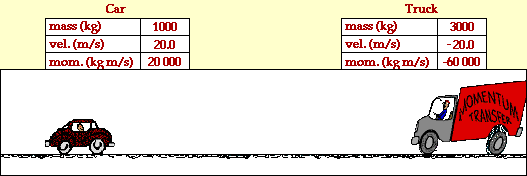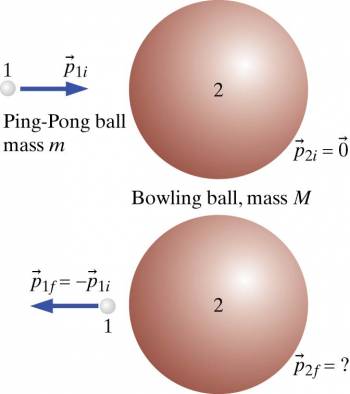Head-on Collision of Unequal Masses: Difference between revisions
No edit summary |
|||
| Line 23: | Line 23: | ||
In an orbiting spacecraft a ping-pong ball of mass m (object 1) traveling in the +x direction with initial momentum <math>p_1i</math> hits a stationary bowling ball of mass M (object 2) head on. What are the '''a) momentum''', '''b) speed''', and '''c) kinetic energy''' of each object after the collision? Assume little change in the speed of the ping-pong ball, and assume that the collision is elastic. | In an orbiting spacecraft a ping-pong ball of mass m (object 1) traveling in the +x direction with initial momentum <math>p_1i</math> hits a stationary bowling ball of mass M (object 2) head on. What are the '''a) momentum''', '''b) speed''', and '''c) kinetic energy''' of each object after the collision? Assume little change in the speed of the ping-pong ball, and assume that the collision is elastic. | ||
# | #<math>-p_1i + p_2f = p_1i | ||
p_2f = 2p_1i</math> | |||
= | |||
==Connectedness== | ==Connectedness== | ||
Revision as of 17:40, 27 November 2015
Main Idea
The two main types of collisions are Elastic Collisions and Inelastic Collisions, but these are very broad as there are many much more specific types of collisions under these umbrella terms. One of the specific types of collisions is head-on collisions of unequal masses. This is exactly what it sounds like - two objects of different masses collide with each other head-on, and this causes some changes in kinetic energy and speed. This can be thought of as two different types of cars colliding with each other, but to make the visualization a bit easier, think about a ping pong ball colliding with a bowling ball.
 Elastic head-on collision between a car and truck[1]
Elastic head-on collision between a car and truck[1]
The Equations Behind It
The most common type of head-on collision of unequal masses studied is an elastic collision, and if this is the case kinetic energy is conserved. What this means is that the total final kinetic energy of the system is equal to the total initial kinetic energy of the system. In equations, it looks like this: [math]\displaystyle{ {1 \over 2}m_1v_1i^2 + {1 \over 2}m_2v_2i^2 = {1 \over 2}m_1v_1f^2+ {1 \over 2}m_2v_2f^2 }[/math].
If the equation is inelastic, the idea of conservation of momentum can be used because momentum is always conserved in collisions. The equation for the conservation of momentum is: [math]\displaystyle{ m_1v_1i^2 + m_2v_2i^2 = m_1v_1f^2 + m_2v_2f^2 }[/math]
Let's talk about a specific example to truly understand what happens in a head-on collision of unequal masses. As referenced to before, the ping pong and bowling ball example clearly expresses what happens. Assuming the bowling ball is at rest when the ping pong ball hits it, the final momentum of the bowling ball is twice the initial momentum of the ping pong ball. This can be seen by using the conservation of momentum principle: [math]\displaystyle{ p_1f + p_2f = p_1i + p_2i }[/math]
Knowing the speed of the ping pong ball remains about the same, the new equation is [math]\displaystyle{ -p_1i + p_2f = p_1i }[/math] which gives [math]\displaystyle{ p_2f = 2p_1i }[/math] showing that the final momentum of the bowling ball is twice the initial momentum of the ping pong ball. Although this is a very specific circumstance, different variables of the equation can be solved by using the conservation of momentum principle.
Example
In an orbiting spacecraft a ping-pong ball of mass m (object 1) traveling in the +x direction with initial momentum [math]\displaystyle{ p_1i }[/math] hits a stationary bowling ball of mass M (object 2) head on. What are the a) momentum, b) speed, and c) kinetic energy of each object after the collision? Assume little change in the speed of the ping-pong ball, and assume that the collision is elastic.
- [math]\displaystyle{ -p_1i + p_2f = p_1i p_2f = 2p_1i }[/math]
Connectedness
- How is this topic connected to something that you are interested in?
- How is it connected to your major?
- Is there an interesting industrial application?
History
Put this idea in historical context. Give the reader the Who, What, When, Where, and Why.
See also
Are there related topics or categories in this wiki resource for the curious reader to explore? How does this topic fit into that context?
Further reading
Books, Articles or other print media on this topic
External links
Internet resources on this topic
